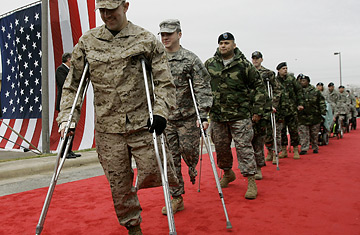
Wounded soldiers arrive for the official dedication of the Center for the Intrepid, a $50 million high-tech rehabilitation center designed to serve the growing number of soldiers who return from war as amputees or with severe burns, in San Antonio, Monday, Jan. 29, 2007.
But Uncle Sam is making way for a growing citizens' army looking to do their part for a war whose terrible toll has only been felt by a very small group of Americans. The volunteers brigade has contributed everything from special needs homes to jobs, but nothing as sweeping as the center dedicated Monday. The $50 million facility was built entirely from private funds and handed over to the Brooke Army Medical Center here as the largest gift — and the only fully designed and equipped hospital — ever given by charity to the government. Funds flowed in from 600,000 donors, checks ranging from $1 to $1 million, primed by Don Imus radio pitches and Avon sales of patriotic pins.
The rehab center was inspired by a group of philanthropists led by the Fisher family, New York real estate moguls who have long provided housing for visiting families of hospitalized soldiers. Brooke, which houses the military's burn unit and some combat amputees from the South, donated land for the 60,000-sq.-ft. facility. With its cutting-edge technology, Intrepid will become a world rehab center and replace Walter Reed as the most desired venue for the wounded. That nearly 100-year-old hospital, which has received most major casualties from Iraq and Afghanistan, is scheduled to close in 2011.
Congress authorized $8.5 million to build a new amputee center there for the intervening years, but Intrepid's sponsors proved the superiority of the private sector. They outspent the federal facility, made it more high-tech and finished faster — the Walter Reed project began planning well before Intrepid but is still far from finished.
Intrepid will be able to care for as many as 100 patients, including a couple dozen maimed soldiers who entered Monday's dedication ceremony on crutches and wheel chairs. Once the place officially opens next month, they will benefit from a rehab regime that my platoon of wounded warriors could only have dreamed of.
Those with missing or withered legs will calibrate their prostheses in a "gait lab," a rotating platform that looks like the hull of a rowboat surrounded by video images of a lake. Upper-extremity patients will learn how to scale a 30-foot climbing wall with prosthetic or injured arms.
When patients come and go from Intrepid, they'll pass a large, black stone sculpture in the courtyard, called "Broken Circle." The circular object is jaggedly linked at its bottom, a symbol for those who will go through life imperfect but complete.
